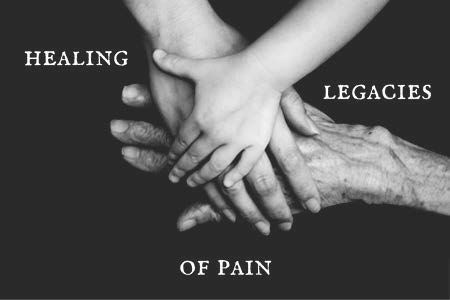Trauma has occurred throughout human history. Awful things have happened to people that overwhelm the ability to cope and have effects that last for a long time.
Most of the time when we talk about trauma the focus is on individuals – how individual persons experience and are affected by traumatic events. However, recent research has shed light on the ways that trauma’s impact can be much broader than that. Whole families, communities, and groups of people in society can be affected by the same traumatic event. The effects of trauma can be passed down through from one generation to another. In other words, trauma can be shared by whole groups and spread across generations.
How does that happen? The answer is not a simple one. There are many ways that trauma can be shared, spread, and passed along as a legacy.
Before going any further into the mechanisms of multigenerational trauma, a reminder of two very important things everyone should know about trauma:

- Trauma is never the fault of the individual or group experiencing the trauma. Being traumatized does not reflect an inherent deficiency or inferiority in the individual or group. Bad things happened to them, not because of them, and certainly not because they deserve it.
- Post-traumatic stress disorder (PTSD) is not the predominant reaction to traumatic events. Individuals, groups, and societies differ in the ways they experience, process, and remember events. Most people who experience a traumatic event will recover naturally. It is only a small subset of survivors whose ability to cope will be overloaded and for whom the recovery process breaks down. These are the ones who become stuck in a post-traumatic state.
WHO IS AFFECTED?
nonetheless reporting symptoms of trauma, anxiety and depression related to their parents’ experiences during the Holocaust.The phenomenon of multigenerational trauma first gained attention in the 1960’s when clinicians began seeing an increasing number of adult children of survivors of the Nazi Holocaust seeking treatment for mental health concerns. These clients had not experienced trauma directly but were Similar patterns were later observed other groups including children
of Japanese-Americans who had been interned during World War II, Native Americans, children of the Rawandan genocide, children whose parents survived the Dutch famine of 1944-45, children of war veterans, and children born to mothers who survived the 9/11 terror attacks.
That list might give the impression that multigenerational trauma is something experienced only in the aftermath of a major historical event like a genocide, famine, or war. Multigenerational trauma does not require a massive event to occur. It also happens in families in which abuse has occurred generation after generation. It is evident in families and communities that have endured oppression, violence, and discrimination due to their race, ethnicity, or religion.


PERCEPTIONS OF SELF AND THE WORLD
Traumatic events affect our perceptions of ourselves, each other, and the world. Personal and collective memories are passed down in families and in society to form the story that becomes the foundation for our understanding of who we are, how we fit into the world, and what can be expected from others and from life. The earlier this narrative is passed on to us, the more likely we will be to internalize it, forming the unquestioned truth of “how it is.
If the story that is passed down to us is about strength, resilience in the face of adversity, and belonging, it becomes a source of vitality and of individual and collective pride. It is a resource that can bolster us during difficult times and help us to overcome the challenges life inevitably brings.
If the story is about oppression, failure, and always being less than, it fosters a sense of learned helplessness, futility, and shame. Why would anyone pass down such an awful story, you might ask? It gets passed on because it is what’s known, what has likely been reinforced by personal experiences, and what is accepted as truth. People do what they believe is necessary to prepare the next generation for the world as they know it.
SECONDARY VICTIMIZATION
Knowing that awful things have happened or could happen to someone you love can be traumatizing. This is especially true among people with a strong capacity for empathy (they are aware of and feel the pain and suffering of their loved one), and among people who feel powerless to ease their loved one’s suffering.

Children are often aware that their parent(s) have experienced trauma but don’t know the details of what happened nor of the full impact that the trauma had. This happens for a lot of reasons. It may be too difficult for the parent to talk about what happened. The memory might be just that painful. They might not know how to explain it. They might be afraid that someone who wasn’t there wouldn’t understand. They might believe that they are sparing their child(ren) pain by not telling them.
The unfortunate result of this silence is that children fill in the blanks for themselves, and often what they imagine is pretty awful, if not worse than what actually happened. Unintentionally, through their example, parents teach their children that awful experiences are not to be talked about, which leaves the child feeling alone and unable to reach out for support when facing their own difficulties. Some children feel an implied sense of duty to make up for the suffering that was inflicted upon their parents.
Bringing history out into the open, exposing it to light and talking about it is a necessary part of healing. It relieves the tension and shame associated with trying to keep things hidden. It makes it possible to grieve together and begin construction of a healthy narrative in which trauma is only a part rather than the main theme.
This is the first of a three-part blog series on Multi-generational trauma. Part II in the series will examine Learned Behaviors as part of the trauma cycle. If your child is affected by anxiety, depression or trauma, please contact C&A at 330.433.6075.
Mary M. Kreitz, LPC, CDCA has more than 20 years of experience working in the field of behavioral health. She is currently the lead therapist for the Trauma Program at Child & Adolescent Behavioral Health, is a member of the Stark County Trauma and Resiliency Committee, and is a member of the Unity Coalition to Dismantle Racism in Stark County.
*To continue to support ongoing content on mental health topics, please make a donation at https://childandadolescent.org/give-to-ca/ or use the Venmo mobile app with the handle @CABehavioralHealth.
RECENT POSTS












